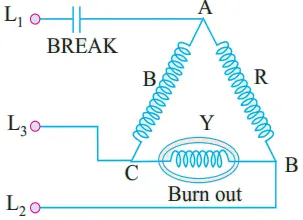Single Phasing of Induction Motor
The single phasing of three phase induction motors forms the most common hazard to motor operation, because of the possibility of overheating and burning-out of the motor under this condition.
By single-phasing is meant the opening of one wire (or leg) of a three-phase circuit whereupon the remaining leg at once becomes single-phase.
When a three-phase circuit functions normally, there are three distinct currents flowing in the circuit. As is known, any two of these currents use the third wire as the return path i.e. one of the three phases acts as a return path for the other two.
Obviously, an open circuit in one leg kills two of the phases and there will be only one current or phase working, even though two wires are left intact. The remaining phase attempts to carry all the load.
Causes of Single Phasing of Induction Motor
The single phasing of induction motor can occur because of causes external to the motor which are:-
- A blown fuse on the transformer primary
- A blown fuse on the motor branch circuit. The usual cause of single-phasing is, what is generally referred to as running fuse, which is a fuse whose current-carrying capacity is equal to the full-load current of the motor connected in the circuit. This fuse will blow-out whenever there is overload (either momentary or sustained) on the motor.
- A loose or poor connection in the switch or starter.
- A loose or broken lead.
It can also occur on account of causes within the motor itself like badly soldered winding connections or an ‘open’ within the winding.
Effect of Single Phasing in Induction Motor
If single-phasing occurs when the motor is stationary, the motor will fail to start. It will merely give a humming sound. Current drawn by it under this condition will be 87% of the starting current under the normal condition. In fact, due to heavy standstill current, it is likely to burn-out quickly unless immediately disconnected.
If single-phasing occurs when the motor is working,
- If motor is already running and carrying half load or less, the motor will continue running as a single-phase motor on the remaining single-phase supply, without damage because half loads do not blow normal fuses.
- If motor is very heavily loaded, then it will stop under single-phasing and since it can neither restart nor blow out the remaining fuses, the burn-out is very prompt.
Which phase is likely to burn-out in single-phasing?
In the single-phasing of delta-connected motor, shown in Fig. 1, the Y -phase connected across the live or operative lines carries nearly three times its normal current and is the one most likely to burn-out. The other two phases R and B, which are in series across L2 and L3 carry more than their full-load currents.

Protection from Single Phasing of Induction Motor
The protection against overloads is normally provided by thermal type overload relays. These relays provide adequate protection to motors if the setting of relays is related to the load conditions because in that case, the relays can sense the overload and isolate the motor before any damage to the insulation can occur as a result of overheating.
The most critical condition occurs where a motor is loaded between 40 to 60% because below 40% load there is no overloading and the motor can deliver the load without damage till single-phasing is detected.
For loads above 60% of the rated load, the rise in the line current is such that the overload relay can take notice of the over-current even if the relay is set for 100% current. In the range of 40 – 60% load, protection by overload relays will be provided if their setting corresponds to the load on the motor.
Where motors above 15 KW may have to work for long periods on part loads of 40 – 60%, additional protection by single-phase preventers, which trip the starter on any serious imbalance in the currents of three-phases will be necessary.
In other cases, protection by thermal relays is more than adequate. In motors below 15 KW, the designs are such that no serious over-heating of the winding takes place even in the range of 40 – 60% load.
The occurrence of single phasing of induction motor can be minimized or eliminated by proper maintenance. The use of re-wirable type fuses is not recommended for motor circuits because of their unreliable operation.
Thanks for reading about “single phasing of induction motor”. If you find my articles informative and helpful, please share them on social media to support me.